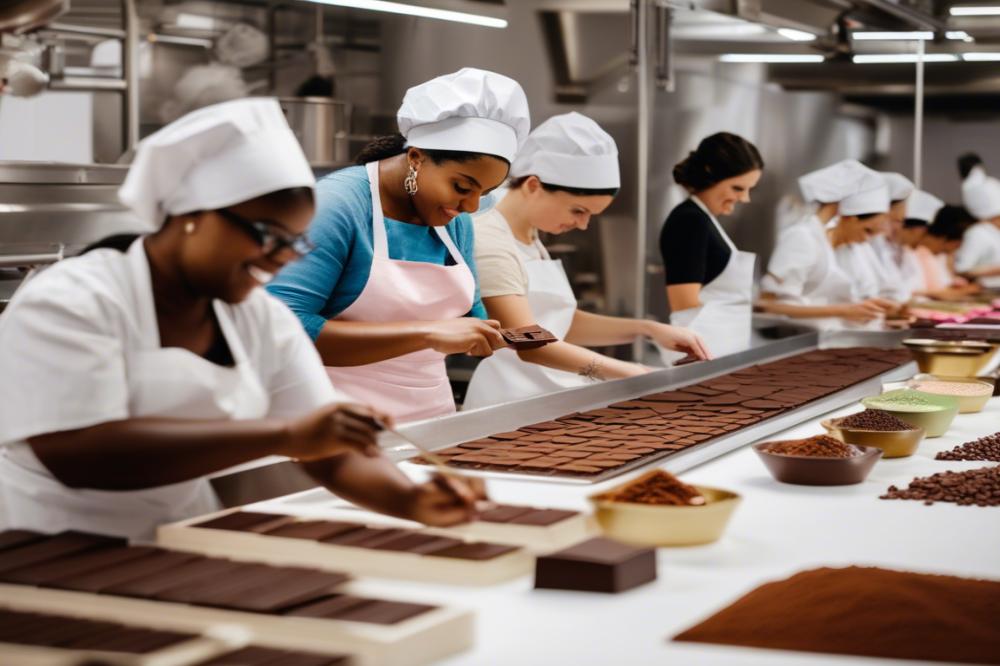Overview of the chocolate industry in the US
The chocolate industry in the United States is expansive and complex. It generates billions of dollars each year, with a broad array of products ranging from traditional bars to gourmet treats. This market thrives on innovation and adaptation, keeping up with changing consumer tastes. Trends in healthy eating and fair trade practices have influenced production and purchasing habits. The craft chocolate movement has gained momentum recently, emphasizing quality and sustainable sourcing.
Significance of Women in Chocolate

Women play a crucial role in shaping this vibrant sector. Many female chocolatiers have emerged as leaders, creating unique brands that focus on quality and ethics. Their involvement is not just about making chocolate; it is a matter of empowerment and entrepreneurship. By stepping into roles traditionally held by men, they challenge the status quo. This shift contributes to greater gender equality within the industry. Female-led businesses bring a fresh perspective to confectionery innovation.
Women Breaking Barriers in Chocolate Making

Across the country, women are pushing boundaries in chocolate making. They delve into sustainable practices and emphasize the importance of diversity in business. Some women are at the forefront of artisanal chocolate. Others lead large corporations, advocating for positive changes. Those who create craft chocolate often strive for transparency and quality. Their efforts have made the industry more inclusive. It’s inspiring to see many women overcoming obstacles and achieving success. They set examples for future generations by proving that passion and hard work lead to triumph in the competitive US Confectionery world.
Women in Chocolate
Female chocolatiers play a vital role in the chocolate industry. They are creators, innovators, and leaders. Each woman brings her own perspective, changing the way people view chocolate. Leadership in this field often reflects the broader push for gender equality in business.
Historical Context of Women in the Chocolate Industry
Historically, the chocolate industry has been male-dominated. Women have often been the unsung heroes, working behind the scenes or in low-profile roles. In the past, few women received recognition for their contributions. However, even during those times, many women were making chocolates and developing recipes at home. This passion laid the groundwork for today’s craft chocolate artisans.
Profiles of Prominent Women Chocolatiers and Their Contributions
Several female chocolatiers have made significant impacts in recent years. For example, Amanda Williams owns a renowned chocolate shop focused on sustainable chocolate production. Her dedication to sourcing ethically harvested cacao has inspired many. Innovative flavors and a commitment to quality define her brand.
Another standout is Julia Baker, who combines art and confectionery innovation in her work. Baker explores the intersection of sweets and storytelling. This approach brings a fresh perspective to chocolate making. Each creation reflects her unique experiences and heritage.
Women like these are role models for future entrepreneurs. They encourage diversity in business and promote women empowerment. Their stories shine a light on the importance of support and community among female chocolatiers.
Many of these women also advocate for fair practices and community-focused efforts. This highlights the importance of not just creating delicious products, but also making a positive impact. By prioritizing social responsibility, they set a standard for others in the industry. The journey of women in chocolate continues to evolve, bringing new flavors and ideas to the forefront.
The Impact of women leadership in the Chocolate Industry
Women in leadership roles play a crucial part in shaping the chocolate industry. Their perspectives bring diversity that enhances creativity and innovation. Diverse teams often solve problems in new ways and find unique solutions. The input of female chocolatiers can lead to breakthroughs in flavor and confectionery innovation.
Importance of Women in Leadership Roles
Having women in key positions helps promote gender equality in the business world. Their presence can inspire younger women who dream of entrepreneurship. This shift in leadership style fosters a more inclusive environment. When women lead, companies often benefit from greater community engagement and sustainability practices.
Case Studies of Women-Led Chocolate Businesses
One inspiring example is Rachel from “Sweet Delights.” She started her own craft chocolate brand, focusing on sustainable chocolate sourcing. Through her leadership, the company has thrived, blending quality with ethics. Similarly, Mia founded “ChocoLuxe” with a vision to create diverse flavors. Her innovative approach has captured the attention of many consumers, leading to expanded reach.
Influence of Female Leadership on Company Culture and Innovation
Leadership by women positively impacts company culture. Employees feel valued and included, leading to higher job satisfaction. This kind of environment encourages creativity, allowing for experimentation in product development. Emphasizing women empowerment, businesses like “The Cocoa Collective” champion social responsibility, ensuring their operations support local farmers and communities.
In essence, the chocolate industry benefits significantly from women in leadership. Their involvement not only creates opportunities but also redefines the standards of success and ethics. As these trailblazers continue to break barriers, they pave the way for a more equitable and innovative future in the confectionery world.
Entrepreneurship and Gender Equality
The craft chocolate sector is witnessing a significant rise in female entrepreneurs. Women are stepping into roles as chocolatiers and business owners, carving out paths that were once dominated by men. The growth of female-led businesses in this area highlights a shift toward greater gender equality in the chocolate industry.
However, this journey is not without challenges. Women entrepreneurs often face hurdles such as access to funding and mentorship. The confectionery market can be competitive, making it difficult for newcomers to establish themselves. Additionally, the expectations placed on women to balance work and family life can create additional pressure.
Overcoming Barriers
Despite these obstacles, many women forge their own paths to success. Building strong networks is one strategy that has proven effective. Female chocolatiers often connect with each other to share experiences and offer support. Such partnerships foster women empowerment and encourage creativity.
Emphasizing sustainable chocolate production also sets some businesses apart. This focus not only appeals to consumers looking for ethical options but also showcases commitment to diversity in business. Using innovative techniques helps to keep products fresh while attracting a loyal customer base.
Investing in education and training can further aid female entrepreneurs. Learning from industry experts and attending workshops enables women to refine their skills. Knowledge of current trends in confectionery innovation empowers them to stand out in a crowded market.
Balancing personal and professional lives remains tough for many. Supporting one another through shared experiences creates a community of strong women leaders. Such solidarity acts as a pillar for those aspiring to succeed in the chocolate field.
Ultimately, the landscape for female chocolatiers continues to evolve. With increased visibility and recognition, these women are paving the way for future generations. As entrepreneurs break new ground, the chocolate industry transforms into a more inclusive space.
Diversity and Inclusion in Business
The importance of diversity in the chocolate industry cannot be overstated. A variety of perspectives leads to enhanced creativity and innovation. By including women and diverse voices, companies can better reflect their customer base. This, in turn, helps businesses thrive in a competitive market.
Efforts to promote gender equality and women empowerment in this sector are gaining momentum. Many organizations now actively support female chocolatiers. Grants, training programs, and resources are made available to encourage entrepreneurship among women. These actions not only empower individuals but also boost the overall industry.
Women in leadership roles inspire others. They pave the way for future generations to enter the craft chocolate space. Mentorship programs connect experienced chocolatiers with newer talent. Such relationships foster collaboration and growth. Community support plays a vital role, as it creates networks that amplify women’s voices in the confectionery world.
Sustainable chocolate practices are also enhanced through diverse leadership. Women bring unique insights to ethical sourcing and production methods. Their influence can drive companies toward more responsible practices. By embracing diversity in business, the chocolate industry can create a more equitable future for all.
Ultimately, the combination of gender equality, mentorship, and community creates a strong foundation for success. A diverse group of leaders can innovate and address the challenges faced by the industry. As female chocolatiers break down barriers, they show the world that excellence in chocolate knows no gender. Their achievements mark a significant shift in the confectionery landscape.
Sustainable Chocolate: A Women-Driven Movement
The connection between women and sustainable practices in chocolate making is profound. Many female chocolatiers recognize the importance of environmental responsibility. They are not just creators of sweet treats; they are also advocates for the planet. Their work reflects a strong commitment to ethical sourcing and eco-friendly processes.
Leading the Way
Female chocolatiers are at the forefront of this movement. For instance, Amanda Stone, founder of a small craft chocolate company, has made sustainability a core part of her brand. She sources cacao from farms that practice regenerative agriculture. These farms not only provide quality beans but also promote biodiversity. Another example is Maya Smith, who has launched a line of chocolates using only organic ingredients. Her efforts contribute to a cleaner environment and healthier communities.
The Industry Impact
Movement towards sustainable chocolate is reshaping the industry. Companies are beginning to understand that consumers care about where their chocolate comes from. This shift is promoting gender equality as more women step into leadership roles. Their perspectives often lead to innovative practices within the confectionery world.
Diversity and Empowerment
Women empowerment plays a crucial role in this transformation. When women lead in business, they bring fresh ideas and diversity to the table. This diversity in business can lead to better decision making and more comprehensive solutions to industry challenges. The rise of female entrepreneurship in the chocolate world is a testament to this reality.
A Brighter Future
The choices made by these women create waves throughout the chocolate industry. Their sustainable initiatives not only benefit the immediate community but also inspire future generations. By practicing sustainable chocolate making, they show others the value of protecting the environment while running a successful business. The intersection of craft and conscience in chocolate can change the narrative for good.
Confectionery Innovation Through a Female Lens
Women in leadership positions have started reshaping the chocolate industry across the United States. A wave of female chocolatiers is driving incredible innovations with fresh ideas. They embrace the craft chocolate movement while introducing unique flavors and artisanal techniques. Their contributions are both artistic and practical, creating treats that enchant consumers and inspire other bakers.
Trends led by women often focus on sustainability and ethical sourcing. Female chocolatiers prioritize sustainable chocolate production, ensuring that the cacao comes from responsible farms. They actively support gender equality by empowering women in their supply chains. This commitment extends beyond the kitchen, influencing how products are marketed and sold. Many women-led brands promote awareness about the importance of diverse business practices.
Entrepreneurship plays a significant role in these changes. Female chocolatiers frequently experiment with ingredients that traditional chocolatiers might overlook. Spicy chocolates, herbal blends, and fruity infusions are now more common in artisan shops. Such variety speaks to a broader audience, inviting new consumers to try innovative treats and expand their palates.
The future for women-led chocolate innovation appears bright and promising. More women are entering the confectionery scene, bringing fresh perspectives that challenge the status quo. With increasing enthusiasm for diversity in business, the industry is expected to continue evolving. It is likely that more consumers will seek out products made by female artisans as awareness grows about the benefits of supporting women in trade.
As these talented women continue to flourish, their impact shapes the chocolate landscape. The passion for making quality products resonates with customers who crave authenticity. This connection not only builds brand loyalty but also enhances the movement toward a more equitable industry. Engaging and inspiring, the stories of female chocolatiers encourage future generations to pursue their dreams in the confectionery world.
Looking Ahead: Women in the Chocolate Industry
Women play a crucial role in shaping the chocolate industry today. Their contributions are not just important; they are vital to the growth and diversity of this field. As chocolatiers, they bring fresh perspectives and innovative ideas. These qualities help to break down barriers that have existed for far too long. The stories of female artisans, entrepreneurs, and leaders inspire others to follow suit and dream big.
Supporting these talented women in chocolate is essential. By choosing to buy products from female chocolatiers, consumers can make a difference. It’s not merely about enjoying delicious treats; it’s about fostering an environment where diversity thrives. Business landscapes need varied voices, and women leadership is one of those voices that can drive meaningful change. Everyone can play a part in amplifying these voices.
The future looks promising for women in this sweet sector. With more females entering the field, the potential for growth is endless. New initiatives and collaborations are forming every day. As the industry evolves, so does the chance for women to take prominent roles. It’s clear that the chocolate world is becoming more inclusive and equitable.
In summary, the contributions of women in chocolate cannot be overlooked. By supporting their endeavors, we enrich the entire industry. Let’s commit to celebrating diversity and continue the movement forward. Each of us can be part of the change that allows creativity and talent to flourish. Together, we can create a brighter future for all.



